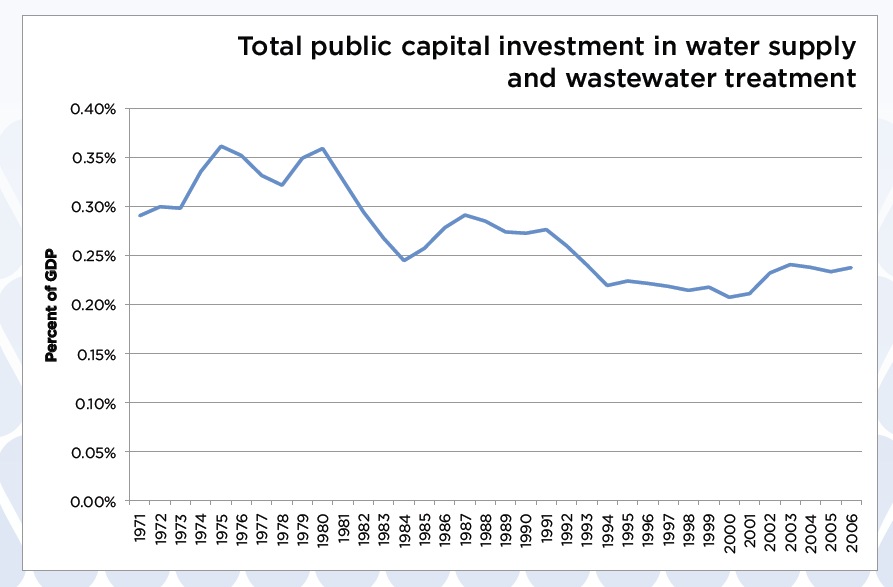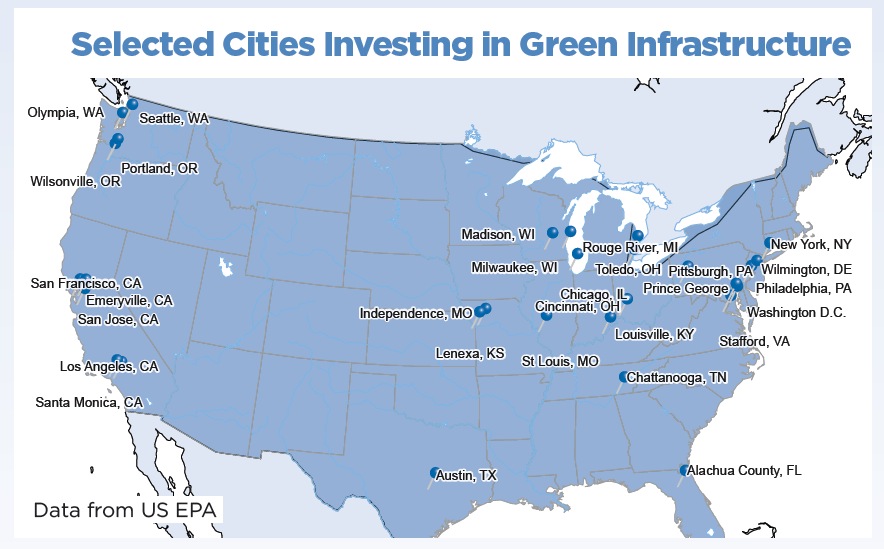GREEN FOR ALL
Executive Summary
This report estimates the economic and job creation impact of a major investment in water infrastructure in the United States. This number—$188.4 billion—is based on the level of investment necessary, as estimated by the Environmental Protection Agency, to manage stormwater and preserve water quality across the country. We find that an investment of $188.4 billion spread equally over the next five years would generate $265.6 billion in economic activity and create close to 1.9 million jobs.
We argue that maximizing the use of green infrastructure—infrastructure that mimics natural solutions—is essential to meet the stormwater management needs of our communities while also providing a number of additional co-benefits.
We provide job creation estimates for each of the 50 states and review the workforce opportunities that would result from such an investment, analyzing a representative set of occupations in industries related to water infrastructure. We find that new jobs generated by these investments could be good jobs that are broadly accessible to American workers.
Water Works examines why a significant level of investment in water infrastructure and, in particular, stormwater infrastructure, is so necessary right now. It reviews evidence of a water and wastewater infrastructure in the U.S. that is outdated, overextended, and in crisis.
We find that our decaying water infrastructure pollutes our waters, sickens our children, and wastes natural resources. Every year, sewer overflows contaminate U.S. waters with 860 billion gallons of untreated sewage, an amount that could fill 1.3 million Olympic size swimming pools or cover the entire state of Pennsylvania with one inch of sewage. This sewage contains pathogens such as bacteria, parasites, and viruses, as well as pharmaceuticals, synthetic hormones, and personal care products.
As our water infrastructure deteriorates, we also find that investment is not keeping pace. Total public investment in water infrastructure as a share of the economy is estimated to have fallen by over one-third since peak levels of investment in 1975. As new challenges emerge and systems deteriorate further, we are seeing a growing gap between our clean water needs and annual investment.
In this report, we argue that the decline in America’s water infrastructure, and its associated economic, health and environmental costs, must be reversed. To achieve this reversal will require significant new investments that ensure the highest return possible and provide a multitude of benefits to our communities. This kind of strategic approach requires not only making traditional infrastructure upgrades but also pursuing new approaches, in particular green infrastructure techniques. Although an increasing number of cities are implementing green infrastructure strategies, these opportunities have not been realized as extensively as their multiple benefits warrant.
Water Works examines why now is best time in a generation to tackle our water infrastructure investment gap, for three key reasons: (1) Water infrastructure investments would create jobs now, when they are most needed; (2) The cost of financing this investment is at historic lows; and (3) The current economic climate can reduce the costs of infrastructure projects.
The report also provides analysis demonstrating that investments in water and other infrastructure are one of the most efficient methods of job creation in the current economy, particularly when compared to other policy prescriptions that often claim the political center stage. Infrastructure investments create over 16 percent more jobs dollar-for-dollar than a payroll tax holiday, nearly 40 percent more jobs than an across-the-board tax cut, and over five times as many jobs as temporary business tax cuts.
Water Works analyzes the quality and accessibility of jobs created by an investment in water infrastructure. We find that most of these occupations do not require high levels of formal education, but rather typically require a high school degree plus some post-secondary education or training. We argue that this labor market dynamic provides an important opportunity to counteract income inequality, by opening up job opportunities with family-supporting wages for “middle-skilled” workers, including low-income people and people of color who have struggled during the current recession.
However, women and people of color are under-represented in many of these occupations, highlighting the need to couple investments in water infrastructure with an economic development strategy to build a society characterized by environmental sustainability and shared prosperity..
This “high road” approach, which we detail in the report’s conclusion, creates family-sustaining jobs, access to economic opportunities for diverse businesses and workers, and supports quality training programs that connect workers to career pathways.
Finally, as cities and municipalities prepare to make these critical investments, we offer guidance in the form of three criteria to ensure a sustainable water future. We conclude that in order to have maximum impact these investments must (1) Create accessible and quality jobs; (2) Maximize environmental gain; and (3) Use financing that is stable, fair, and scalable.
About Green For All
www.greenforall.org
“Green For All is dedicated to improving the lives of all Americans through a clean energy economy. We work in collaboration with the business, government, labor, and grassroots communities to create and implement programs that increase quality jobs and opportunities in green industry – all while holding the most vulnerable people at the center of our agenda.”
Tags: Green for All, Green Infrastructure, Water Infrastructure








 RSS Feed
RSS Feed